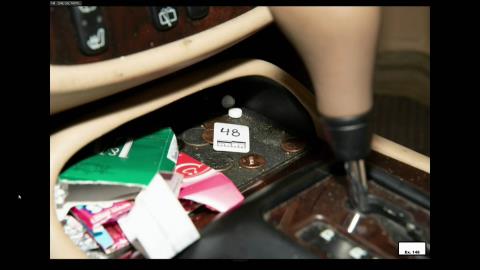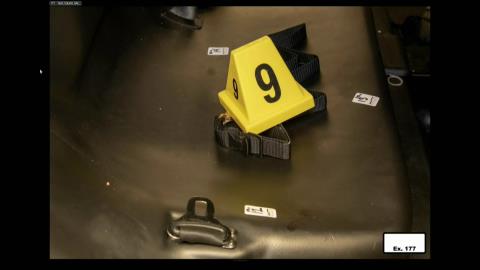
Nelson: Doesn't "saying things like 'you're a f***ing p****, you're a b****" convey a particular intent?
Stiger: "I wouldn't say intent," adding it depends on the officer's training. | cbsloc.al/2PziOKt
Stiger: "I wouldn't say intent," adding it depends on the officer's training. | cbsloc.al/2PziOKt
Nelson calls up surveillance photo outside Cup Foods. Asks Stiger about Chauvin's position, and could that indicate less of his weight on his left side, where his knee is holding down Floyd. Stiger affirms. 
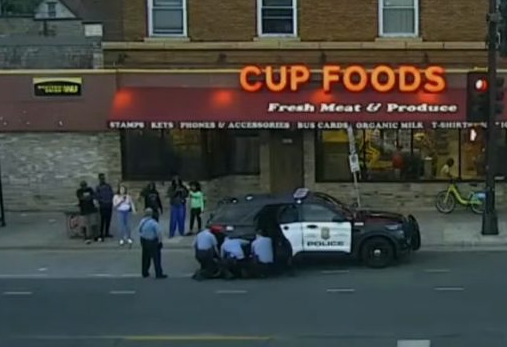
Prosecution's Steven Schleicher begins redirect of witness Jody Stiger by asking about the risks of positional asphyxia, making a distinction between positioning as opposed to pressure and weight.
Schleicher: Is it your opinion...that the force you've identified as applied by [Chauvin] was objectively reasonable or not objectively reasonable?
Stiger: It was not objectively reasonable.
WATCH LIVE: cbsloc.al/3uIJebF
Stiger: It was not objectively reasonable.
WATCH LIVE: cbsloc.al/3uIJebF
Schleicher: Would you agree with the statement 'in your custody, in your care?"
Stiger: Yes.
Stiger: Yes.
Stiger is done testifying.
The state calls their next witness, special agent James Reyerson.
WATCH LIVE: cbsloc.al/3uIJebF
The state calls their next witness, special agent James Reyerson.
WATCH LIVE: cbsloc.al/3uIJebF
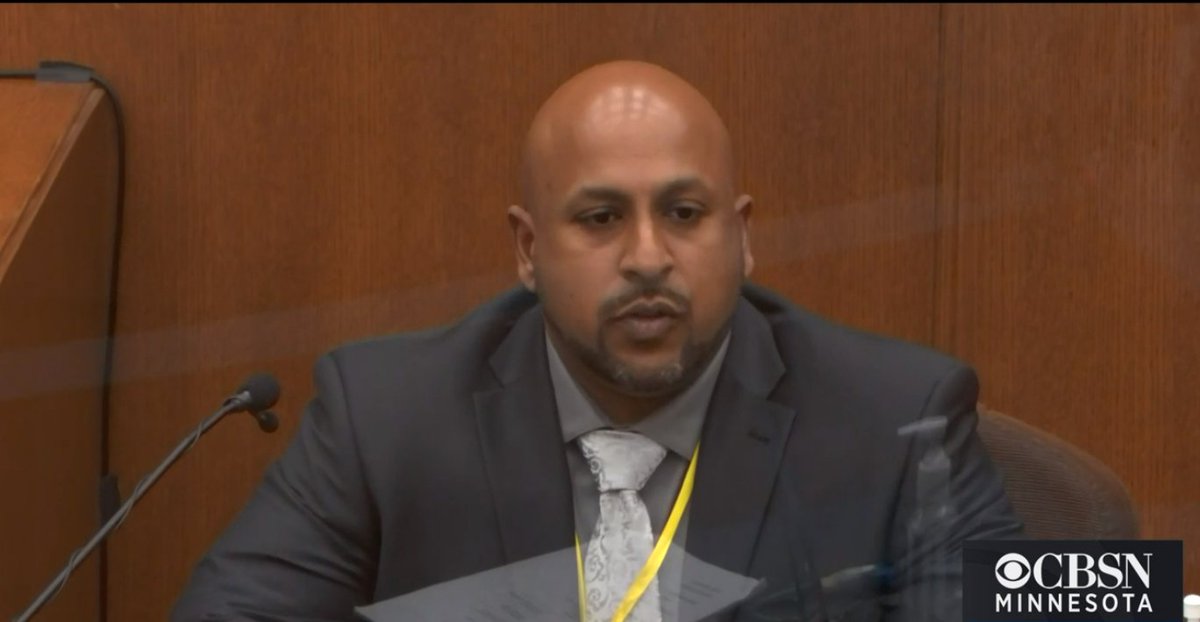
Reyerson is assigned to a newly-formed use of force unit in the Minnesota Bureau of Criminal Apprehension.
He is now detailing his work history, which includes time at the NYPD and the DEA.
Reyerson is from Minnesota.
He is now detailing his work history, which includes time at the NYPD and the DEA.
Reyerson is from Minnesota.
Reyerson is now saying what happened with the four officers involved in #GeorgeFloyd's death when they arrived at Minneapolis City Hall to speak with investigators.
WATCH LIVE: cbsloc.al/3uIJebF
WATCH LIVE: cbsloc.al/3uIJebF
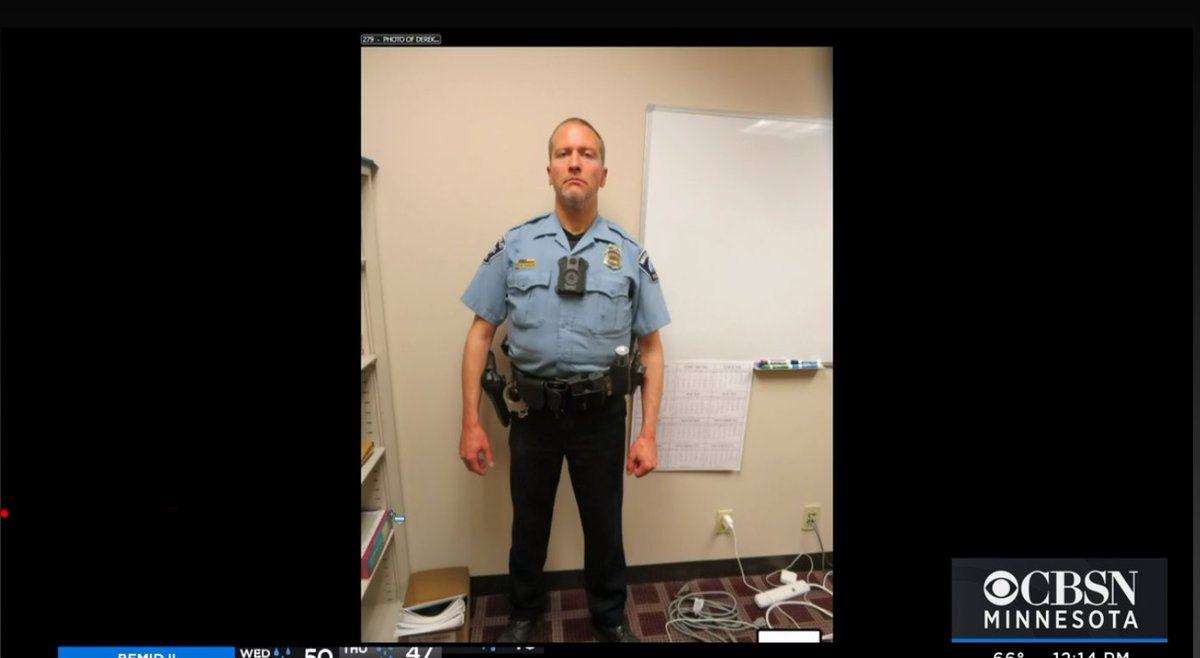
The court is now taking a lunch break.
Court is slated to resume at 1:15 p.m.
Court is slated to resume at 1:15 p.m.
Court is back. Minnesota BCA agent James Reyerson is still on the witness stand. WATCH LIVE: cbsloc.al/3uIJebF
Reyerson is describing what happened to evidence found at the scene - two $20 bills and a pipe were sent away for testing. The squad car and George Floyd's vehicle were towed and processed by the BCA.
Prosecutor Matthew Frank is now questioning Reyerson about surveillance footage of the incident on May 25, 2020. Frank noted discrepancies in the timestamps on body-worn video, video from Cup Foods and video from Dragon Wok, a nearby restaurant.
Frank and defense attorney Eric Nelson are discussing something at the lectern, following a portion of video being mistakenly played. "I'll come back to that subject in a little bit," Frank says afterward.
Frank is now questioning Reyerson about Floyd's autopsy and toxicology reports. WATCH LIVE: cbsloc.al/3uIJebF
Reyerson says he was aware "that Mr. Floyd may been under some influence of some substance," on May 25, but didn't know what kind of drugs. Frank now asking about a request to have Floyd's vehicle further investigated in Dec. 2020.
Reyerson says the defense requested re-processing of the squad car as well, after they found "a pill" during a search. "They drew that to your attention?" Frank asked. "Yes, sir," Reyerson says.
Frank is now showing Reyerson and the jury body camera footage showing the moment when officers put Floyd on the ground outside of squad car 320.
Frank is focusing on the timeline of the officers' restraint of Floyd on the ground. Asks Reyerson to note when Floyd stops verbalizing, when he stops moving and when paramedics arrive.
Frank's questioning is finished. Nelson asks the judge for a moment.
The defense is now questioning Reyerson. WATCH LIVE: cbsloc.al/3uIJebF
Nelson asks Reyerson to confirm that about 50 BCA agents and 25-26 FBI agents were involved in the investigation of Floyd's death.
Nelson's asking Reyerson several questions about the scope of the BCA investigation, including number of interviews, number of reports compiled, etc.
Nelson asks Reyerson to clarify that he wasn't suggesting in testimony that the defense placed the aforementioned pill in squad 320. "No sir, I'm not suggesting that," Reyerson says.
Reyerson testifies that he viewed more than 750 photos from the initial search of the squad car and did not notice any pills.
Nelson: It's not that you didn't preserve the evidence, you just didn't notice it.
Reyerson: That's correct.
Nelson: It's not that you didn't preserve the evidence, you just didn't notice it.
Reyerson: That's correct.
Nelson notes that this BCA investigation was "unusual" because it was occurring simultaneously with a court process.
Nelson: In this particular case, things were unusual because of that.
Reyerson: That is correct.
Nelson: In this particular case, things were unusual because of that.
Reyerson: That is correct.
Nelson is showing body camera footage now, asking Reyerson to note the position of Floyd's left arm.
Nelson: Reyerson: Do you observe Mr. Chauvin's right knee to be compressing Mr. Floyd's left arm?
Reyerson: Clarification, I think from what I see here it was Mr. Chauvin's shin ... and the knee was on the back.
Reyerson: Clarification, I think from what I see here it was Mr. Chauvin's shin ... and the knee was on the back.
Nelson plays a brief clip for Reyerson.
Nelson: Did it appear that Mr. Floyd said "I ate too many drugs"?
Reyerson: Yes it did.
Nelson: Did it appear that Mr. Floyd said "I ate too many drugs"?
Reyerson: Yes it did.
Frank is now questioning Reyerson on redirect.
Frank asks about Reyerson's assessment of what Floyd said in the previous clip.
Frank: That was an exercise that Mr. Nelson asked you to do for the first time sitting there ... without reviewing the conversation beforehand?
Reyerson says yes.
Frank: That was an exercise that Mr. Nelson asked you to do for the first time sitting there ... without reviewing the conversation beforehand?
Reyerson says yes.
Frank finishes his redirect and Nelson comes back to the lectern, asking Reyerson about his answers to questions about the squad car. Judge Cahill asks for a 10-minute break so counsel can discuss an issue.
Court is back. The state is recalling Reyerson to re-address two previous exhibits.
After the state plays the lead-up to the earlier clip in which Reyerson was asked to interpret what Floyd was saying, Reyerson now says, "I believe Mr. Floyd was saying, 'I ain't do no drugs.'"
Nelson is now showing Reyerson surveillance footage from Dragon Wok where a man with Floyd can be seen throwing something to the side. He asks if that's behavior consistent with someone trying to get rid of something they don't want police to find. Reyerson says it can be.
Reyerson has been excused. The next witness is McKenzie Anderson, a forensic scientist for the Minnesota BCA.
Anderson joined the BCA crime scene team in 2014 and became a team leader in 2016.
Anderson says last year she responded to about 30 crime scenes, which she says "was more than normal."
Anderson was called to the scene of Floyd's fatal arrest. She arrived around 1:15 a.m. on May 26 and was at the scene for around two hours.
Anderson was made aware of the bystander video while she was at the scene. "The primary reason for watching it was because we didn't know exactly where the incident had occurred," she said.
The state is now showing photographs the BCA took at the scene.
Frank: Did you collect any evidence from the scene?
Anderson: No, there was no evidence collected from the scene.
Anderson: No, there was no evidence collected from the scene.
Anderson says the vehicles from the scene were processed on May 27 by herself, a team member and an agent taking photographs.
Frank: When you processed these vehicles, what kind of information did you have about the incident itself?
Anderson: There really was very little additional information that was known at the time.
Anderson: There really was very little additional information that was known at the time.
Frank: Did you have any information about whether [Floyd] may have been under the influence of something?
Anderson: No, I did not have that information at that time.
Anderson: No, I did not have that information at that time.
Frank asks Anderson about what appears to be a white pill in the car. She says she did not have any indication at the time that the case involved pills. She also says she removed some money from the vehicle during processing.
Anderson says she was asked to search the car a second time in Dec. 2020. "I was given specific things to look for ... I was told to collect ... pills in the center console, gum if there was any gum present, money..."
This BCA photo shows an open suboxone packet. Anderson says suboxone is "a prescription medication used for adults with an opioid addiction." 
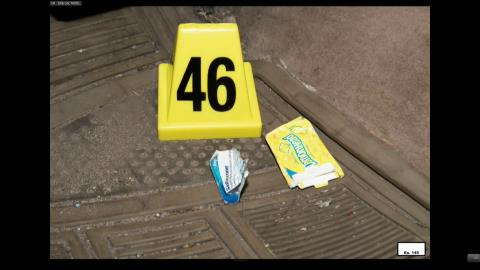
Frank now asking Anderson about the white spot seen near the center console in this photograph. It was initially covered by a shoe. "At the time I didn't give it any forensic significance," she says. 

Frank: Did [the pill] appear like it wasn't whole any longer?
Anderson: Yes, I think that's a fair statement, yes.
Anderson: Yes, I think that's a fair statement, yes.
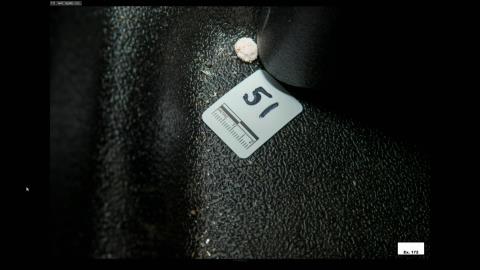
Anderson also marked the object in this photograph. "It was a small, irregular shaped piece that could've been a portion of the pill," she says. 
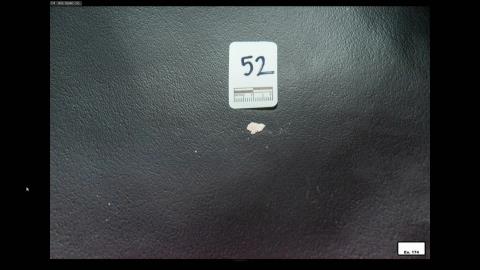
Anderson says she did DNA testing on eight blood samples from the squad car and bills from Floyd's vehicle, as well as item 51 (the pill seen earlier in this thread).
Frank: In what ways can DNA be left behind for forensic testing to be done?
Anderson: ... through a bodily fluid ... by touching an object or handling an object. It can be found also in the root of your hair.
Anderson: ... through a bodily fluid ... by touching an object or handling an object. It can be found also in the root of your hair.
Anderson performed testing which indicated there had been saliva on item 51 at one time. She says the DNA profile she found on item 51 matched a previous profile from George Floyd.
Anderson says seven stains tested presumptively positive for blood.
Frank: So that was George Floyd's blood?
Anderson: Yes, essentially.
Anderson: Yes, essentially.
Court is taking a 10-minute break.
Court is back. Chemical forensic scientist Breahna Giles of the MN BCA is now on the witness stand, being questioned by the state. WATCH LIVE: cbsloc.al/3uIJebF
Giles tested a pipe found at the scene and is describing the testing process now. "There was only visible charred residue."
Giles says testing revealed the residue contained THC, but "there was no visible plant material that was able to be identified as marijuana."
Giles also tested a pill. Says they had pharmaceutical markings, but she didn't immediately recognize them.
Giles actually tested two pills with markings. When she looked up the markings, they indicated the pills contained "oxycodone and acetaminophen."
Frank asks if homemade pills can sometimes be given these markings to make them appear legitimate. She said yes.
Further testing revealed the pills contained methamphetamine and fentanyl.
Testing on other items found in squad car #320 also revealed methamphetamine.
Frank wraps up his questioning. The defense will cross examine. WATCH LIVE: cbsloc.al/3uIJebF
Nelson begins by asking about the weights of the items Giles tested.
Nelson asks about other substances potentially found in the car.
Anderson: There were indications of other substances. I can't speak to if they were controlled or uncontrolled substances.
Anderson: There were indications of other substances. I can't speak to if they were controlled or uncontrolled substances.
Nelson asks if the other substance was fentanyl.
Anderson: I can't confirm.
Nelson: Because it simply didn't meet that laboratory requirement.
A: The testing I did did not have any quantitative measurement.
N: You can't say it was or wasn't fentanyl?
A: Yes.
Anderson: I can't confirm.
Nelson: Because it simply didn't meet that laboratory requirement.
A: The testing I did did not have any quantitative measurement.
N: You can't say it was or wasn't fentanyl?
A: Yes.
A new witness, forensic chemist Susan Neith, is now on the stand. WATCH LIVE: cbsloc.al/3uIJebF
Neith tests evidence for substances. Says she's performed "approximately 6,000 tests, approximately 4,000 of which were quantitative analysis."
Neith tested three pills she received from the BCA in this case.
Neith tested the pills for both fentanyl and methamphetamine.
For all three of the pills, the fentanyl concentration "was less than 1%," according to Neith's report.
Neith says that amount is common in her quantitative analysis of street fentanyl. Says the methamphetamine levels found are low. "Majority of the time I see 90 to 100 percent methamphetamine."
Nelson declines cross examination and court is in recess until tomorrow morning.
Correction: The above quotes attributed to "Anderson" should actually be attributed to Breahna Giles.
Correction: The above quote attributed to "Anderson" should actually be attributed to Breahna Giles.
• • •
Missing some Tweet in this thread? You can try to
force a refresh


